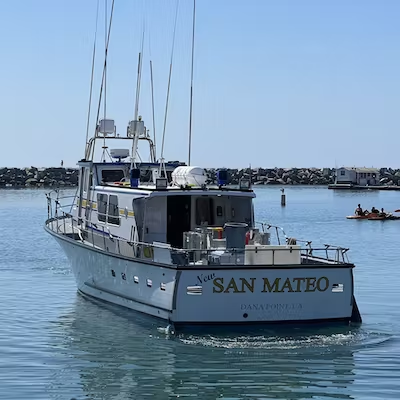How To Catch More Yellowfin Tuna

How To Catch More Yellow Fin Tuna
Yellow fin tuna are a prized catch for many anglers. Their speed, strength, and size make them a thrilling challenge.
Yet, catching these magnificent fish is no easy task. It requires knowledge, skill, and the right gear.
In this guide, we’ll share effective strategies and techniques for catching yellow fin tuna. We’ll cover everything from understanding their behavior to choosing the right bait.
Whether you’re a seasoned angler or a beginner, you’ll find valuable insights here. Our tips will help you increase your catch rates and enhance your fishing skills.
We’ll also highlight the benefits of fishing with Dana Wharf Sport Fishing.

So, let’s dive in and learn how to catch more yellow fin tuna.
Understanding Yellow Fin Tuna Behavior
Yellow fin tuna are highly migratory species. They follow warm ocean currents and food sources.
They also tend to stay deeper during the day and come closer to the surface at dawn and dusk. This behavior is crucial when deciding the best fishing times.
Yellow fin tuna are also attracted to floating debris and Fish Aggregating Devices (FADs). These can be hotspots for tuna fishing.
Best Times and Conditions for Yellow Fin Tuna Fishing
Yellowfin are highly seasonal off Southern California, with the best chances typically from July through October when warm offshore waters push north.
In Dana Point, the peak season for yellow fin tuna is from late summer to early fall. This is when the water temperature is ideal for them. Check out our month to month fish guide!
Water temperature plays a significant role in yellow fin tuna fishing. They prefer warm waters, typically between 65° and 82°F.
Sea surface temperature charts can be a valuable tool. They help locate areas where yellow fin tuna might be present.
Remember, patience and persistence are key. Even under ideal conditions, finding and catching yellow fin tuna can be challenging.
Locating Yellow Fin Tuna: Tips and Techniques
Finding yellow fin tuna requires understanding their behavior. They often travel in schools and are attracted to certain oceanic features.
Look for signs of baitfish or birds diving into the water. This often indicates the presence of yellow fin tuna.

Using fish finders and sonar technology can also be beneficial. These tools can help locate schools of yellow fin tuna beneath the surface.
Fishing around floating debris and Fish Aggregating Devices (FADs) can also be effective. Yellow fin tuna are often found near these structures.
Remember, stealth and a quiet approach are crucial. Yellow fin tuna can be easily spooked by noise and sudden movements.
Essential Gear for Yellow Fin Tuna Fishing
The right gear can make a significant difference in your yellow fin tuna fishing success. A sturdy, high-capacity reel and a strong, flexible rod are essential.
Consider using fluorocarbon leaders. They are nearly invisible underwater, which can help fool wary yellow fin tuna.
Circle hooks are recommended for conservation. They are designed to hook the fish in the mouth, making catch and release easier.
Finally, a well-maintained boat and reliable equipment are crucial. Breakdowns and equipment failures can ruin a promising fishing trip.
Bait and Lure Selection for Yellow Fin Tuna
Choosing the right bait or lure is a critical aspect of yellow fin tuna fishing. Live bait, such as mackerel or sardines, can be very effective.
Artificial lures also have their place. Color selection can play a role in their effectiveness.
Consider using poppers for surface fishing. They can be particularly effective when yellow fin tuna are feeding near the surface.
Remember, the key is to match your bait or lure to the conditions and the feeding habits of the yellow fin tuna.
Trolling Strategies for Yellow Fin Tuna
Trolling is a popular method for catching yellow fin tuna. It involves dragging lures or bait behind a moving boat.
The speed of the boat is crucial. It should mimic the speed of the baitfish that yellow fin tuna feed on.
Setting up your trolling gear properly is also important. Use outriggers to spread your lines and avoid tangles.
Remember to keep your fishing line tight at all times. A slack line can result in missed bites.
Finally, be patient. Trolling for yellow fin tuna can take time, but the rewards are worth it.
Alternative Techniques: Jigging and Popping
Jigging and popping are two other effective techniques for yellow fin tuna fishing.
Jigging involves dropping a weighted lure vertically into the water and jerking it up and down. This mimics the movement of a wounded baitfish, attracting the attention of the tuna.
Popping, on the other hand, uses a floating lure or ‘popper’. The popper is jerked across the surface of the water, creating a splash that mimics a distressed baitfish.
Both techniques require a good deal of physical effort. But they can be highly effective when yellow fin tuna are feeding near the surface.
Remember to adapt your techniques based on the size and type of yellow fin tuna you’re targeting.
Fighting and Landing Yellow Fin Tuna
Catching a yellow fin tuna is a thrilling experience. These fish are known for their strength and speed, making them a challenging catch.
The key to landing a yellow fin tuna is to keep the fishing line tight at all times. This prevents the fish from throwing the hook.
When the tuna is near the boat, use a gaff or net to secure it. Be careful not to pull the fish out of the water until it’s tired out. This reduces the risk of losing the fish at the last moment.
Dana Wharf Sport Fishing Experience
Charter services like Dana Wharf Sport Fishing offer a unique fishing experience. They provide expert guidance and all the necessary equipment for a successful fishing trip.
Dana Wharf Sport Fishing is known for its yellow fin tuna fishing trips. They have experienced crews who know the best fishing spots and techniques.
Hiring a charter can increase your chances of catching yellow fin tuna. It also allows you to focus on the fishing experience, without worrying about boat maintenance or navigation.
Conservation and Sustainable Fishing Practices
Conservation is a crucial aspect of fishing. It ensures the sustainability of yellow fin tuna populations for future generations.
Practices like catch and release, using circle hooks, and respecting fishing regulations play a significant role. They help maintain a healthy balance in the ocean ecosystem.
Remember, responsible fishing is not just about the catch. It’s about preserving the sport and the environment for years to come.


